How to Run an Estate Sale: Expert Tips for Success
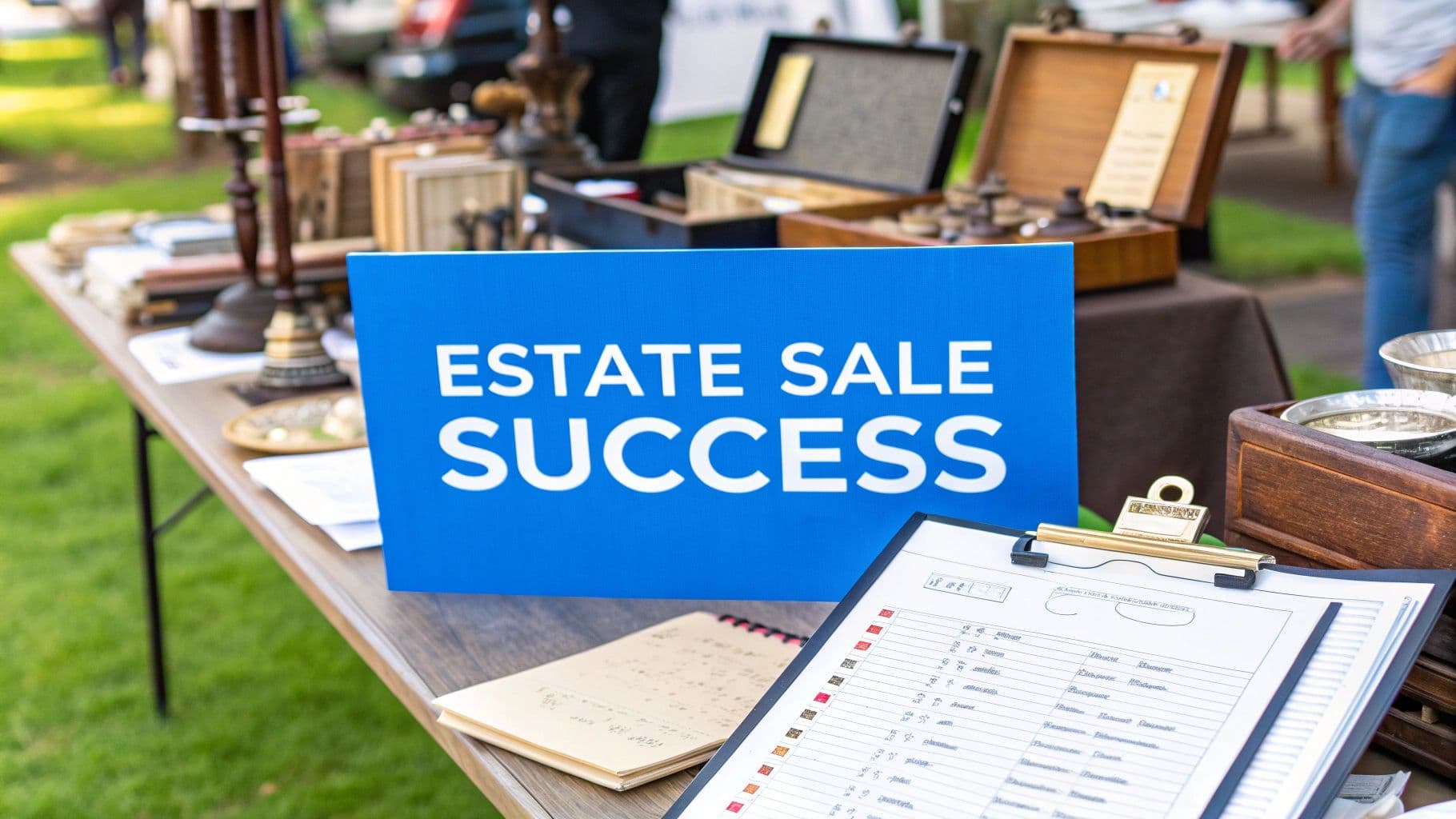
Getting started with an estate sale can feel overwhelming, especially when you're dealing with the emotions that often come with it. The first big decision you'll face is a crucial one: should you run the sale yourself or bring in a professional company? This choice sets the stage for everything that follows.
Your First Steps to a Successful Estate Sale
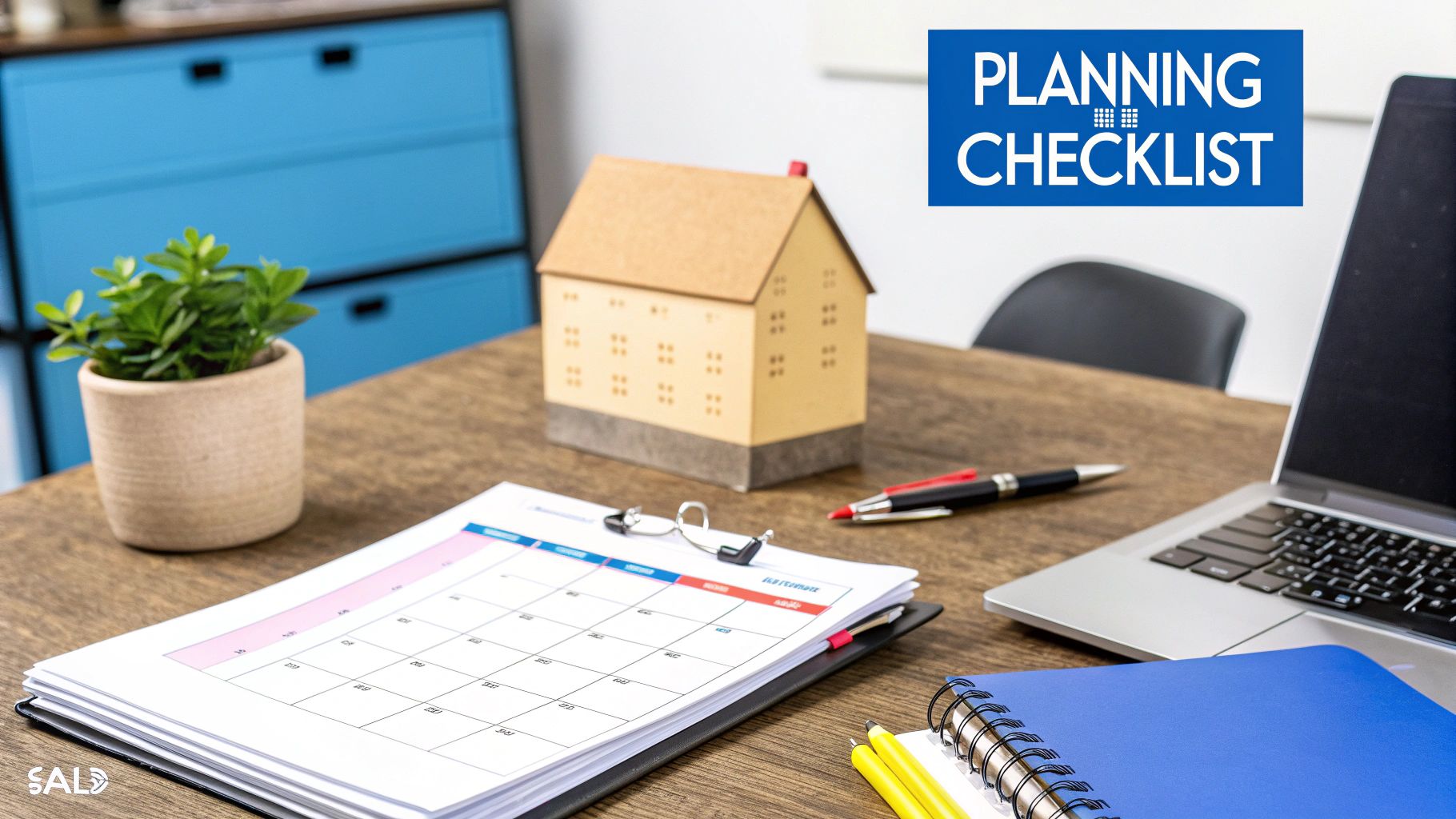
Tackling the sale on your own, especially with a platform like DIYAuctions, puts you in the driver's seat. You have complete control and can sidestep the steep commissions that traditional estate sale companies charge—often anywhere from 35% to 50% of your total proceeds. That's a huge chunk of your money.
Of course, hiring a full-service company has its place. It can lift the weight of the hands-on work, which might be the best option if you're managing the estate from another state or simply don't have the time to dedicate to it.
When you're weighing your options, think about the "three T's": Time, Treasure, and Temperament. Do you realistically have the hours to put in? Is the value of the items (the treasure) worth your personal effort? And honestly, do you have the emotional temperament to see the process through?
Once you’ve decided on your approach, the next step is to map out a realistic timeline. I've seen it time and time again—people seriously underestimate how long each stage of an estate sale actually takes.
Building Your Timeline
A solid timeline is your best defense against last-minute panic. It ensures nothing important falls through the cracks. In my experience, a typical sale needs a good two to four weeks of focused preparation before you even think about opening the doors or launching the auction.
Here’s a rough breakdown of what that looks like:
- Week 1: The Lay of the Land & Legal Check-In. This is when you'll talk with family, figure out who has the legal green light to sell everything, and start a basic inventory. No need for fine details yet, just a general idea of what you're working with.
- Weeks 2-3: Sorting, Staging, and Pricing. Get ready, because this is where the real work happens. You’ll be sorting every single item into piles: sell, keep, donate, or trash. It's the most time-consuming part of the whole process.
- Week 4: Marketing Push & Final Prep. Now's the time to shout it from the rooftops. You'll focus on advertising your sale, taking excellent photos of your items, and getting the home staged and ready for buyers.
This schedule gives you a clear path forward. For a deeper dive, we've put together a ton of great advice in our complete list of estate sale tips for sellers that can help you master each step.
Understanding Your Responsibilities
Knowing how to run an estate sale isn't just about selling stuff; it's also about understanding your legal and financial obligations. If you're the executor of the estate, you have what's called a fiduciary duty to the heirs. Simply put, it means you're legally required to act in their best interest, which includes getting fair market value for the assets being sold.
It is absolutely vital to keep detailed records of every sale and every expense. This paper trail is your proof of transparency for other beneficiaries and is essential for accounting. You’ll also need to check your state's sales tax laws—you might be on the hook for collecting and remitting it. Getting this foundational work right from the start ensures your sale is not only profitable but also compliant and headache-free.
Sorting and Organizing to Uncover Hidden Value
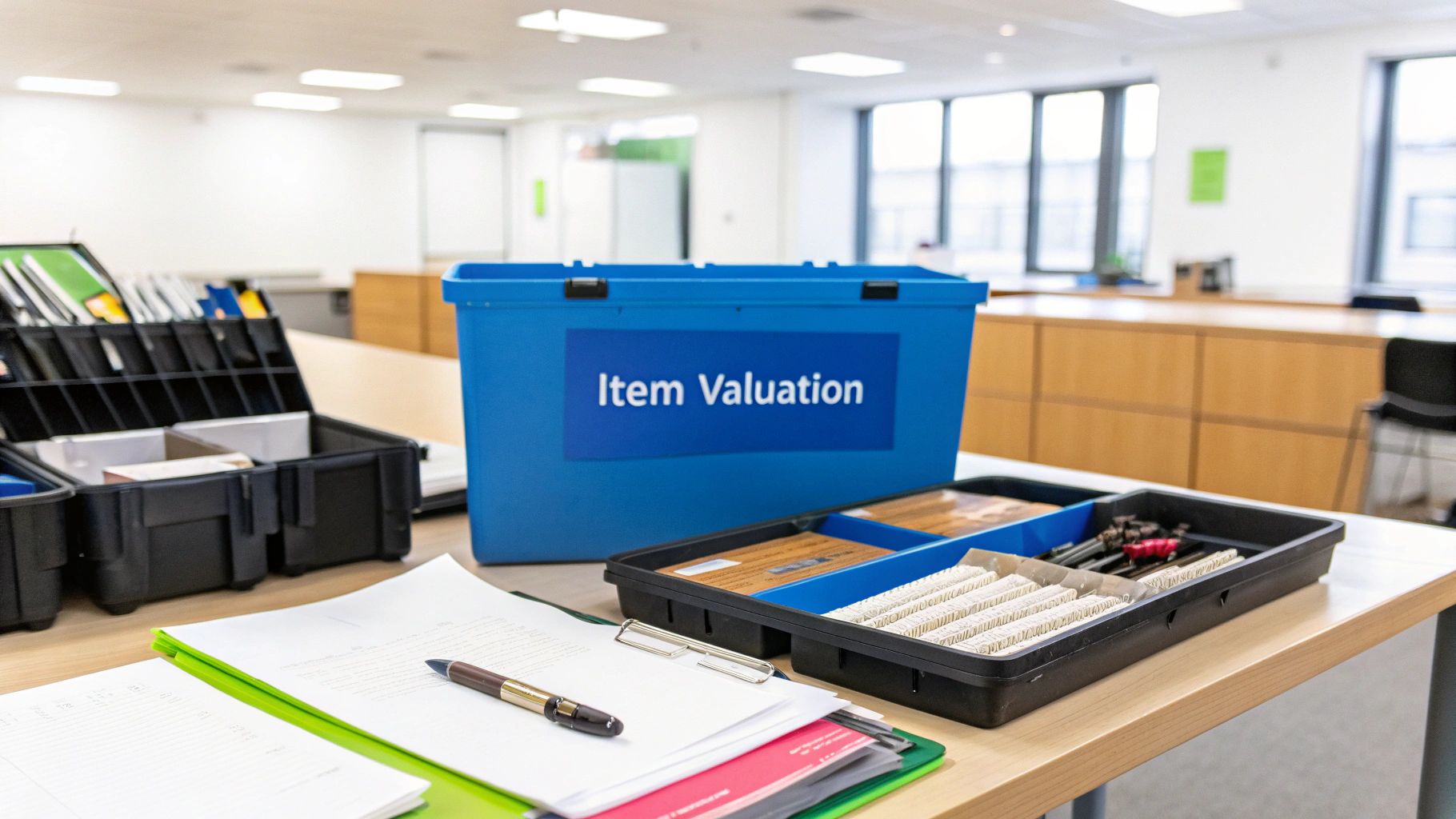
Now that you have a plan, it's time to roll up your sleeves for what is often the most labor-intensive part of the entire process. But don't be intimidated—this is where the real magic happens. You’re about to turn a house full of possessions into a well-organized collection of treasures, ready for your online auction. Think of it less as cleaning and more as a treasure hunt.
The best way I’ve seen this done is with a simple but effective sorting system. Before you touch a single item, designate different zones or use colored tape for four key categories: Sell, Keep, Donate, and Discard. This simple framework is a lifesaver. It cuts down on decision fatigue and keeps you moving forward, room by room.
This methodical approach is absolutely critical when running your own estate sale. It stops you from getting bogged down and ensures every single item is handled with intention.
A Practical Room-by-Room Method
My advice? Stick to one room at a time. Pick a starting point, clear out a central space on the floor, and get to work. Go through every single drawer, closet, shelf, and box, placing each item into one of your four piles. The urge to bounce between rooms is strong, but trust me, it’s a fast track to burnout and confusion.
While you're sorting, keep a sharp eye out for personal papers—things like financial records, passports, photos, and letters. These should be pulled aside and secured immediately. It’s an easy thing to miss when you're in the zone, so make it a priority right from the start.
Dealing with sentimental items is tough; there’s no way around it. Give yourself and your family the space to decide what stays. That said, it’s smart to set a firm deadline for these decisions to keep your sale on track. Once an item lands in the "Keep" pile, get it off the property. This prevents it from being accidentally sold or causing confusion on pickup day.
The goal here is to build an objective inventory for your sale. Once an item has been processed emotionally and lands in the "Sell" pile, start thinking of it as merchandise. Making that mental switch is crucial for running a profitable, low-stress event.
Uncovering and Enhancing Value
This hands-on sorting phase is your golden opportunity to spot items with hidden value. It’s amazing what can be overlooked. You'll want to watch for everyday things that collectors go crazy for.
Here are a few categories people often miss:
- Vintage Clothing and Accessories: Don’t just see an old coat; look for designer labels, unique patterns, or quality materials. A 1960s dress or a classic leather handbag can be a fantastic find.
- First-Edition or Signed Books: Flip to the copyright page. What looks like just another hardcover could be a first edition worth hundreds.
- Old Tools and Kitchenware: That heavy cast-iron skillet or set of colorful vintage Pyrex? Highly sought-after. The same goes for quality old hand tools.
- Ephemera: This is a big one. Don't toss out old postcards, stamp collections, concert ticket stubs, or vintage magazines without doing a quick online search. These paper goods can hold surprising value.
After you've sorted everything, shift your focus to presentation. A little bit of elbow grease at this stage can seriously boost an item's final sale price. Simple things like wiping down dusty furniture, washing glassware, or plugging in electronics to show they work can add 10-20% to what a buyer is willing to pay.
A word of caution: avoid major restorations, especially on antiques. Sometimes, a "fix" can actually lower the value. Your goal is simply to present each piece in its best, cleanest light, ready for its next chapter. This attention to detail really separates a great estate sale from an average one—and it shows up in your final payout.
Setting Prices and Staging for a Killer Sale
Okay, you’ve sorted through everything. Now comes the part where all that hard work starts turning into real money: pricing and staging. This is where the magic happens. It’s a bit of an art and a science—price things too high and you'll be left with a house full of stuff, but price too low and you’re leaving cash on the table.
Your first move? A little online detective work. Hop on sites like eBay or Facebook Marketplace, but don’t just look at what sellers are asking. You need to filter for "sold" listings. This shows you what people are actually willing to pay for items just like yours, which is crucial for pricing everyday things like kitchen gadgets, tools, or modern furniture.
How to Price Your Items for Maximum Profit
For the more unique stuff, you'll need to dig a little deeper. Getting the price right on certain items can make a huge difference. In fact, research shows that nearly 80% of successful estate sales lean on either professional appraisals or smart, detailed comparisons to online marketplaces.
Why? Because for categories like antiques, collectibles, and quality vintage furniture, proper valuation can lead to final sale prices that are 30-50% higher than what you'd get at a typical garage sale.
If you’ve got a gut feeling about a particular piece—maybe some fine art, old jewelry, or a rare antique—don't just guess. Seriously consider hiring a professional appraiser for those specific items. Their fee is a small investment to avoid the massive mistake of selling a $5,000 item for $50.
For everything else, a tiered pricing approach is your best friend. We break down all the different valuation methods in our comprehensive estate sale pricing guide.
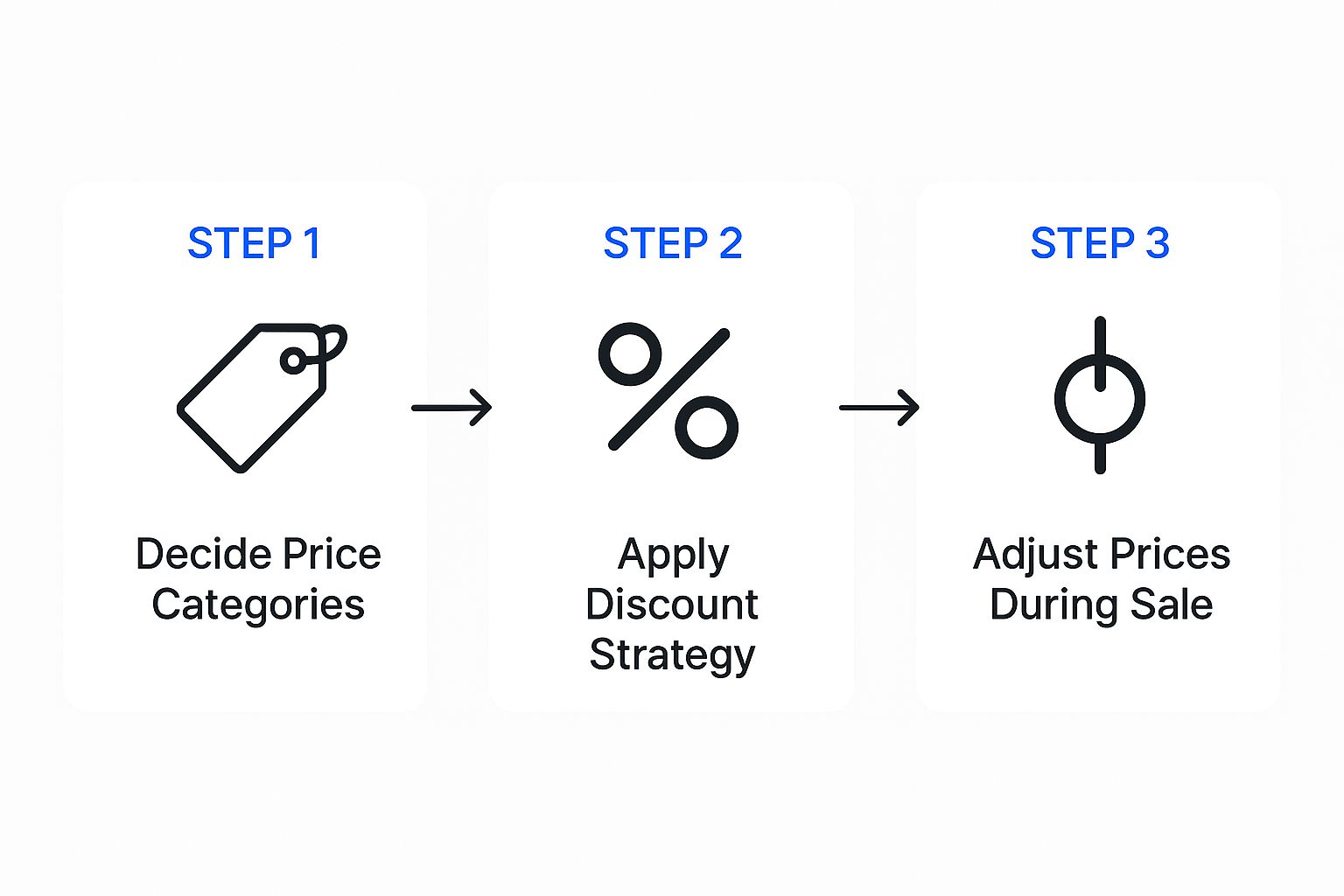
The big takeaway here is that pricing isn't something you do once and then forget about. It's a dynamic process that you might need to adjust as your sale progresses.
Before we move on, let's look at a few common pricing strategies. Each has its pros and cons, and knowing the difference will help you decide what's best for your sale.
Common Pricing Strategies and Their Outcomes
| Pricing Strategy | Description | Pros | Cons |
|---|---|---|---|
| Competitive Market Pricing | Pricing items based on recent "sold" prices for similar goods on platforms like eBay or other estate sales. | Maximizes profit on desirable items; realistic and data-driven. | Requires research time; can be tricky for unique or rare items. |
| Cost-Plus Pricing | Based on the original purchase price plus a small margin. Not generally recommended for used goods. | Simple to calculate if you have original receipts. | Doesn't reflect current market demand or an item's condition; often inaccurate. |
| "Good, Better, Best" Tiering | Grouping similar items and pricing them in three tiers (e.g., all hardcover books are $3, $5, or $8). | Fast and efficient for large quantities of similar items (like books or clothes). | Can undervalue some items and overvalue others within the same tier. |
| Aggressive "Move It Out" Pricing | Pricing items significantly below market value to ensure they sell quickly. | High sales volume; guarantees an empty house. | Leaves significant money on the table; lower overall profit. |
Choosing the right mix of these strategies is key. For most DIY estate sales, a blend of Competitive Market Pricing for valuable items and Tiering for common goods works wonders.
Creating a Shopping Experience That Sells
With your prices locked in, it's time to set the stage. This isn’t just cleaning up; it's about creating a welcoming retail environment that gets people excited to shop. A well-staged home doesn't just look nice—it actively boosts your sales total.
First things first: clear the way. Shoppers need to move around easily, without navigating an obstacle course of boxes and furniture. Then, group similar items together to create mini "departments."
- In the Kitchen: Set the dining table. It helps people visualize using the dishes, glasses, and silverware. Arrange pots, pans, and appliances on the counters so they’re easy to see.
- In Living Spaces: Create little scenes. Put lamps on end tables, drape a nice throw blanket over the couch, and arrange decorative pieces into appealing vignettes.
- In the Bedrooms: Display quilts and linens on the beds. If you have lots of clothes, hang them on racks or in the closets, sorted by type.
This kind of thoughtful setup not only helps buyers find what they're looking for but also helps them discover treasures they didn't even know they wanted.
Think like a store merchandiser. Don’t just throw books in a box—line them up on a bookshelf. Untangle necklaces and lay them out on a velvet tray. Good presentation signals that the items were cared for, which builds trust and makes customers feel more confident about buying.
Lighting is another game-changer. It's non-negotiable. Open every curtain, turn on every light. A bright, cheerful space feels more inviting and lets people really see what they’re buying. If a room is still dim, bring in a few extra lamps to brighten up the corners.
And finally, the simplest but most important detail: every single item needs a clear, easy-to-read price tag. There is nothing more frustrating for a shopper than finding something they love and having no idea how much it costs. This tiny step makes the whole process smoother, prevents bottlenecks, and empowers people to make those quick buying decisions you’re looking for.
Marketing Your Sale to Attract Eager Buyers
You’ve put in all the hard work sorting, organizing, and staging. Now comes the crucial part: making sure people actually show up. A perfectly priced sale means nothing if you're the only one there.
This is your game plan for creating real buzz and guaranteeing a steady flow of serious buyers from the moment you open the doors.
We've found that a modern approach, blending proven digital strategies with old-school tactics, is what truly moves the needle. Organizers consistently report that a strong marketing mix is a complete game-changer. In fact, by fully embracing online platforms—social media, specialized listing websites, and email lists—you can boost your foot traffic by as much as 40%.
This hybrid strategy ensures you’re not missing anyone, from the person scrolling Facebook Marketplace on their couch to the neighborhood bargain hunter who spots your sign on their morning drive.
Crafting Your Digital Footprint
Your online presence is your single best tool for reaching a wide yet targeted audience. This is where you'll build anticipation and show off your best items long before the sale even starts.
It all begins with great photos. Seriously. Use natural light whenever possible, clear away any distracting background clutter, and be sure to capture items from several different angles. When you’re photographing furniture or art, stage it a bit to help buyers imagine it in their own homes.
Next, write descriptions that actually sell. Don't just list "brown chair." Instead, try something like, "Vintage Mid-Century Modern Walnut Armchair with Original Tweed Upholstery." Always highlight brand names, materials, and any interesting history or details you know. Put yourself in the buyer’s shoes: what information would make you want to drive across town?
Pro Tip: I always recommend creating a "highlight reel" of your top 10-15 most desirable items. These are your headliners—the unique antique furniture, signed artwork, or rare collectibles. Feature these showstoppers prominently in all your ads to create a sense of urgency and attract serious collectors.
With your great photos and descriptions ready, it's time to get the word out.
- Estate Sale Listing Sites: Websites like EstateSales.net are absolutely essential. They are the go-to resource for die-hard estate sale shoppers and will bring in a highly qualified crowd.
- Facebook Marketplace: This is a powerhouse for reaching a massive local audience. In the days leading up to the sale, create individual listings for the items in your "highlight reel."
- Local Facebook Groups: Don't stop at Marketplace. Search for and post in your local buy/sell/trade groups, neighborhood community pages, and even special interest groups (e.g., "Vintage Furniture Lovers of [Your Town]").
Using multiple platforms casts the widest possible net, making sure your sale gets seen. Our guide to estate sale marketing dives even deeper into strategies for making your sale the talk of the town online.
The Unbeatable Power of Old-School Signage
While your digital campaign is buzzing, you absolutely cannot forget the power of good, old-fashioned signs. Clear, professional-looking signage is a non-negotiable part of a successful sale. It’s your secret weapon for capturing that incredibly valuable drive-by traffic.
Think bold, simple, and readable from a car. Grab some large, brightly colored poster board—neon pink or yellow are fantastic choices—and use a thick, black permanent marker. Keep the message short and sweet.
| Essential Sign Information | Why It's Critical |
|---|---|
| "ESTATE SALE" | This needs to be the biggest text on the board, easily readable from a distance. |
| Arrow Pointing the Way | Make the arrow massive and unmistakable. There should be zero confusion. |
| Address (on signs near the home) | Only put the full address on signs that are within a block or two of the house for clarity. |
| Dates & Times | List the full schedule, like "Fri-Sun, 9am-3pm," so people know when to come. |
Start at the major intersections at least a half-mile away and plant your signs at every turn. You're creating a trail of breadcrumbs that leads shoppers right to your front door. The morning of the sale, do one last drive-by to make sure all your signs are still up, visible, and pointing the right way.
This simple step can easily add hundreds, or even thousands, of dollars to your final take by pulling in impulse shoppers who might have otherwise driven right on by.
Managing Sale Days and Finalizing the Estate
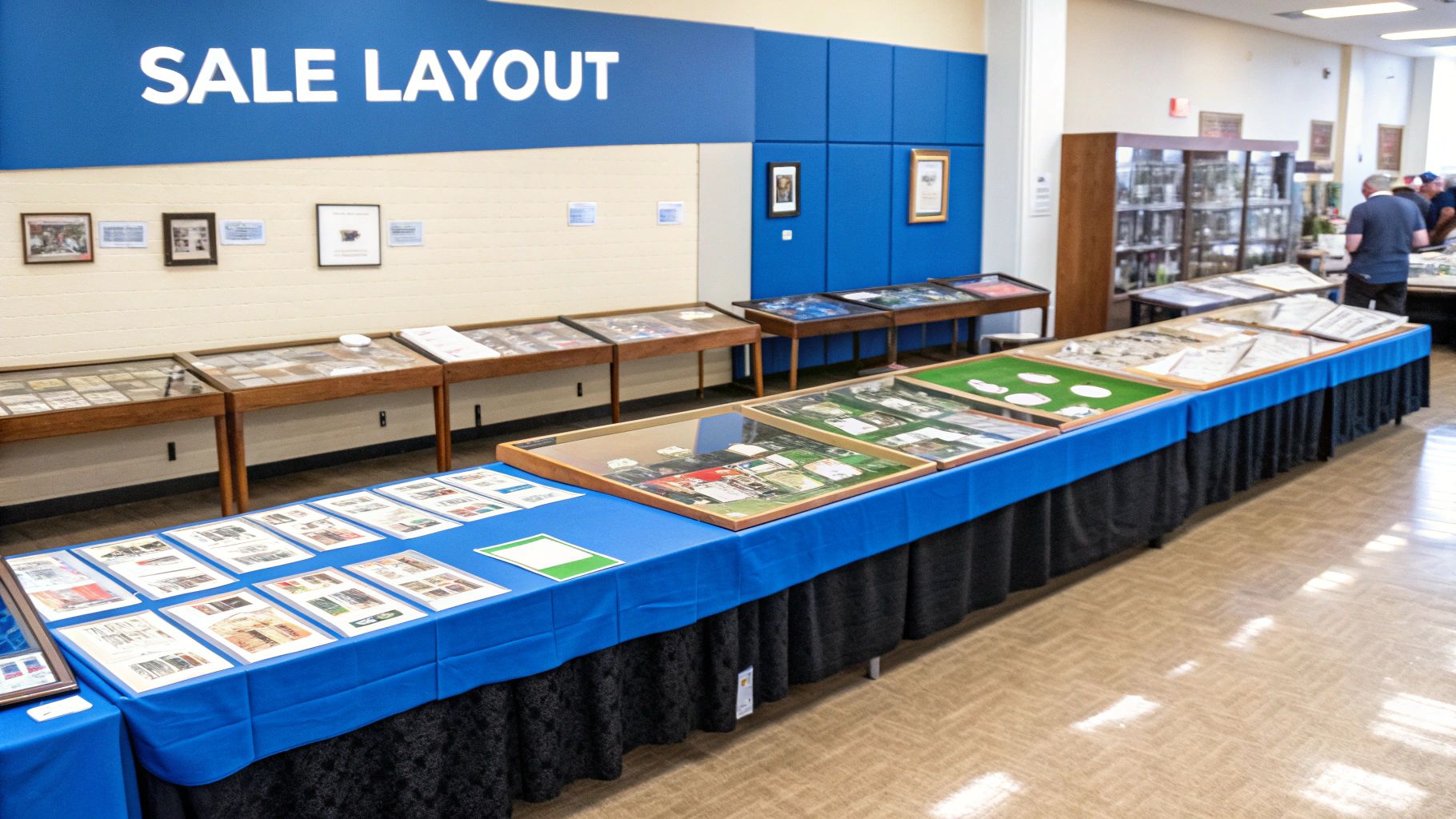
The doors are about to open. After all the sorting, staging, and pricing, this is where your preparation truly shines. The key to a great sale day isn’t just about making money; it’s about controlled execution that keeps things smooth, secure, and even fun for everyone.
From that first rush of eager shoppers to counting the cash at the end, having a solid game plan is essential. Success here is measured just as much by how well you handle the flow of people and products as it is by the final sales total.
Handling the Opening Rush and Crowd Control
Let's be honest: the first hour of any estate sale can be intense. You'll likely have a line of dedicated buyers who showed up early, coffee in hand, ready to find those hidden gems. Your main job is to keep things orderly and safe from the get-go.
A simple but incredibly effective tactic is to limit how many people you let inside at once. I’ve found a good rule of thumb is about 5-7 shoppers for every 1,000 square feet. This gives people room to browse without bumping elbows and dramatically cuts down on the risk of accidental breakage or theft. Just ask a friend or family member to play "door person" to manage the flow.
You should also establish a clear, single entrance and a separate exit. It’s a classic retail strategy that works wonders in a crowded home, preventing those awkward traffic jams in narrow hallways.
The goal is calm, controlled chaos. A positive and organized start sets the tone for the entire event. When shoppers feel safe and respected, they stick around longer and, you guessed it, spend more.
Setting Up a Secure and Efficient Checkout
Think of your payment station as the command center of your sale. It needs to be organized, secure, and dead simple for shoppers to use. Set up a dedicated table near your designated exit, leaving enough room for a line to form without blocking the door.
In this day and age, offering modern payment options is a must. Cash is still around, but you'll lose sales if you can't take a card or mobile payment.
- Payment Processors: Services like Square or PayPal offer easy-to-use card readers that plug right into your phone. They look professional and are incredibly user-friendly.
- Peer-to-Peer Apps: Don't forget about Venmo and Zelle. They're fast, usually have no fees, and are popular with many shoppers. Just have a clear sign with your username or QR code ready.
- Cash Handling: Have a cash box with plenty of small bills and change. As you collect larger bills, periodically stash them away in a secure, out-of-sight spot.
A smooth, multi-option checkout process keeps the line moving and everyone happy. The last thing you want is a buyer walking away from a big-ticket item because of a payment issue.
Creating a Fair Policy for Negotiations
Haggling is part of the culture—and the fun—of estate sales. Deciding on your negotiation policy before you open the doors will save you a ton of stress. A common strategy that works incredibly well is to keep prices firm on the first day, especially when interest is highest.
As the sale progresses, you can start introducing discounts to keep items moving. Here’s a typical structure I recommend:
| Sale Day | Typical Discount Strategy |
|---|---|
| Day 1 (e.g., Friday) | Prices are firm. No negotiations. |
| Day 2 (e.g., Saturday) | Offer a 25% discount on most items. |
| Day 3 (e.g., Sunday) | Offer a 50% discount or more. Be open to bundling. |
Post your discount schedule right at the entrance and at the checkout table. This transparency manages everyone’s expectations and cuts down on the endless "what's your best price?" questions on day one.
Finalizing the Estate After the Sale
Once the last shopper leaves, your work isn't quite over. You will almost certainly have things left. Planning for this final stage is critical to clearing the property and wrapping things up.
Good estate sale management is about more than just profit; it's about clearing a property efficiently. The average sale liquidates 70-90% of items in just 2 to 3 days. For a deeper dive, you can explore trends in high-end estate sales.
For whatever is left, you have a few great options:
- Charity Donations: Organizations like Habitat for Humanity ReStore or the Salvation Army often provide free pickup services for furniture and other large household goods.
- Buyout Companies: These businesses will give you a single, lump-sum offer for everything that remains. It's the fastest way to empty a house, though you'll get less than what the items are individually worth.
- Junk Removal: For anything that can't be sold or donated, a professional junk removal service can clear it all out, leaving the property ready for its next chapter.
By having a plan for the clean-out, you can officially close the books on your sale and meet any deadlines for turning over the property.
Frequently Asked Questions About Estate Sales
Diving into your first estate sale is bound to bring up a few questions. That's perfectly normal. Getting straight answers is the best way to feel confident you’re making the right calls for the estate.
We hear a lot of the same questions from folks just getting started, so we've gathered them here. Think of this as your personal cheat sheet for navigating the process like a pro.
How Long Does It Take to Plan an Estate Sale?
This is, without a doubt, the part of the process people underestimate the most. While every situation is unique, you should realistically set aside two to four weeks for solid preparation. This isn't something you can knock out over a weekend.
That timeframe gives you the breathing room you need for the heavy lifting: sorting through absolutely everything, researching prices, and marketing your sale so people actually show up. The sale itself usually runs for two or three days, typically over a weekend to capture the most traffic. For a particularly large home or one with specialty collections, you might need even more time—sometimes a month or more—to do it justice.
What Is the Difference Between an Estate Sale and a Garage Sale?
It really comes down to scope and purpose. A garage sale is all about clearing out some extra stuff you don't need anymore. It's usually held in the driveway and features a random assortment of personal items.
An estate sale, on the other hand, is a whole different ballgame. It's the complete (or nearly complete) liquidation of a home’s contents, and it happens inside the house.
You're not just selling clutter; you're offering up a lifetime of belongings. This includes everything from the furniture and artwork to the silverware and everyday kitchen gadgets. The goal is to empty the property, usually triggered by a major life event like a death, a big move, or significant downsizing.
What Should I Do With Unsold Items?
Let's get this out of the way: you will have items left over. It’s a simple fact of every single sale. Going in with a plan for the leftovers is critical, especially if you're on a deadline to clear the property.
You’ve got a few great options:
- Charity Donations: Many non-profits, like Habitat for Humanity or the Salvation Army, will often pick up furniture and other large items for free.
- Estate Buyout Companies: These services make a single offer for everything that remains. While you won't get top dollar for each item, it's by far the quickest way to clear a house.
- Junk Removal Services: For anything that can't be sold or donated, hiring a service like 1-800-GOT-JUNK? is the final step to getting the property completely empty and clean.
Should I Clean or Repair Items Before Selling?
Yes, absolutely. A little elbow grease can make a huge difference in your final numbers. You'd be amazed at how simple things like wiping down dusty furniture, polishing a silver platter, or washing a set of glassware can transform an item in a buyer's eyes. It just looks better.
But here’s a crucial warning: do not attempt major repairs or restorations on antiques or valuable collectibles. A well-intentioned but amateur "fix" can absolutely tank an item's value. Your goal isn’t to make something look brand new; it’s to present it in its best possible current state. A clean, well-cared-for item builds trust and tells buyers they’re getting something of quality.